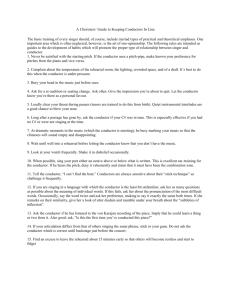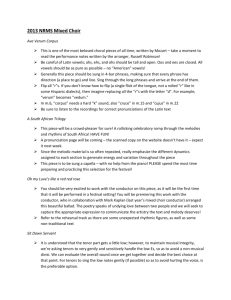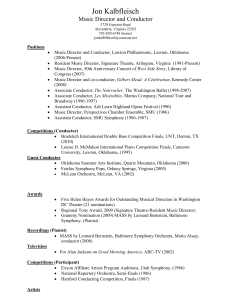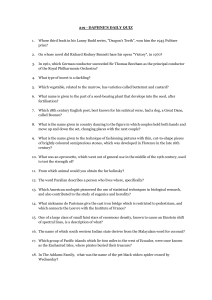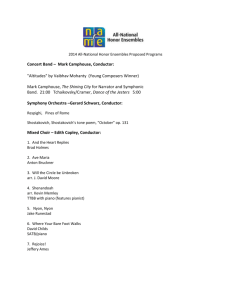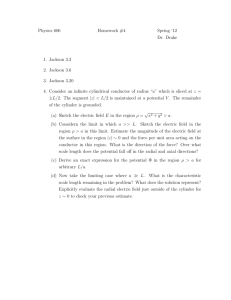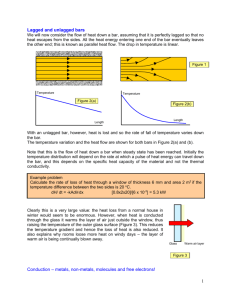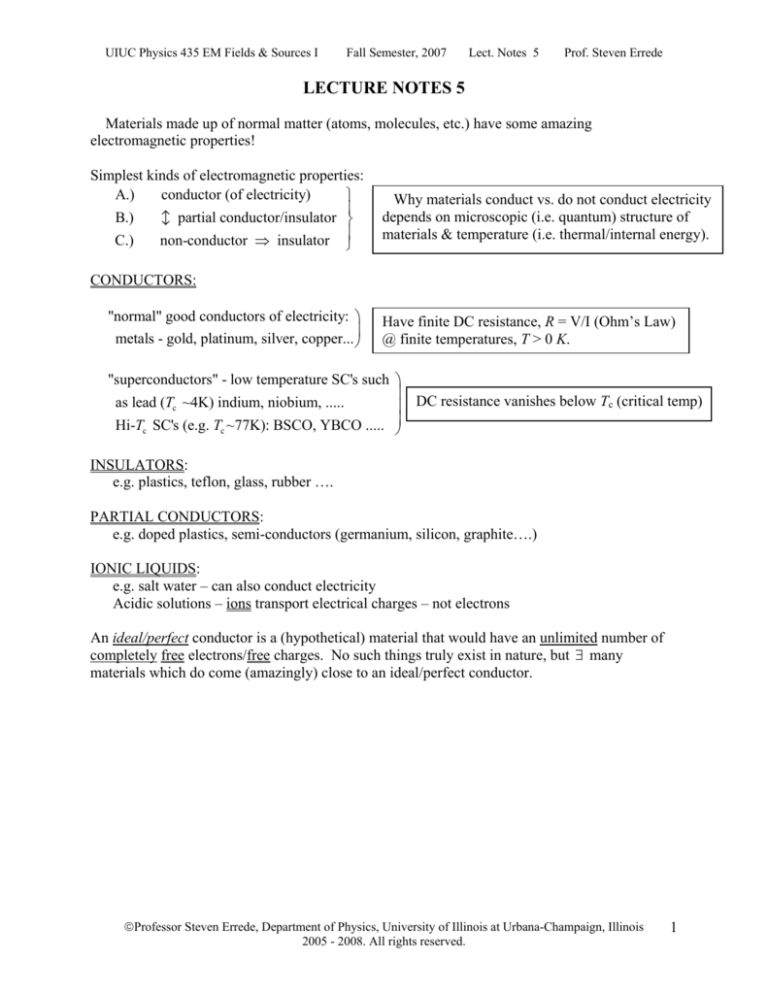
UIUC Physics 435 EM Fields & Sources I
Fall Semester, 2007
Lect. Notes 5
Prof. Steven Errede
LECTURE NOTES 5
Materials made up of normal matter (atoms, molecules, etc.) have some amazing
electromagnetic properties!
Simplest kinds of electromagnetic properties:
A.)
conductor (of electricity)
⎫
⎪
B.)
partial conductor/insulator ⎬
C.)
non-conductor ⇒ insulator ⎭⎪
Why materials conduct vs. do not conduct electricity
depends on microscopic (i.e. quantum) structure of
materials & temperature (i.e. thermal/internal energy).
CONDUCTORS:
"normal" good conductors of electricity: ⎞
⎟
metals - gold, platinum, silver, copper... ⎠
Have finite DC resistance, R = V/I (Ohm’s Law)
@ finite temperatures, T > 0 K.
"superconductors" - low temperature SC's such ⎞
⎟
as lead (Tc ~4K) indium, niobium, .....
⎟
Hi-Tc SC's (e.g. Tc ~77K): BSCO, YBCO ..... ⎟⎠
DC resistance vanishes below Tc (critical temp)
INSULATORS:
e.g. plastics, teflon, glass, rubber ….
PARTIAL CONDUCTORS:
e.g. doped plastics, semi-conductors (germanium, silicon, graphite….)
IONIC LIQUIDS:
e.g. salt water – can also conduct electricity
Acidic solutions – ions transport electrical charges – not electrons
An ideal/perfect conductor is a (hypothetical) material that would have an unlimited number of
completely free electrons/free charges. No such things truly exist in nature, but ∃ many
materials which do come (amazingly) close to an ideal/perfect conductor.
©Professor Steven Errede, Department of Physics, University of Illinois at Urbana-Champaign, Illinois
2005 - 2008. All rights reserved.
1
UIUC Physics 435 EM Fields & Sources I
Fall Semester, 2007
One important property of a conductor is that:
Prof. Steven Errede
n.b. ENET ( r ) ≡ 0 is a different physics statement
than E ( r ) ≡ 0 inside a conductor!
ENET ( r ) ≡ 0 inside a conductor
1)
Lect. Notes 5
If ENET ( r ) = 0 inside a conductor, then free charges inside the conductor would move/be
accelerated by this Einside ( r ) = 0 , because: Finside ( r ) = qe Einside ( r ) = me ae ( r ) .
Indeed, this is precisely what happens inside a conductor e.g. when it is placed in a uniform
external electric field Eext ( r ) = E0 xˆ – the free charges inside the conductor (electrically neutral!)
re-distribute themselves to create/produce Einside ( r ) = 0 on extremely short timescales of ~ femto
→ pico-seconds ( ~ 10−15 − 10−12 sec ) .
The redistributed free charges pile up on the surface(s) of the conductor in such a way as to
produce Einside ( r ) = 0 . These induced charges produce an internal electric field of their own,
which exactly cancels the external field, Eext ( r ) !
e.g. consider a block of metal in a uniform external electric field, Eext ( r ) = E0 xˆ
Enet
inside
( r ) = Eext ( r ) + Einduced ( r ) = 0
inside
⇒ Einduced ( r ) = − Eext ( r ) = − E0 xˆ
inside
Note that: Enet
outside
( r ) = Eext ( r ) when a conductor is placed inside an initially uniform applied
field, Eext ( r )
Induced surface charge, σ
Eext ( r ) = E0 xˆ
2
Induced surface charge, σ ⊕
⎧
⎪
⎪
⎪
⎪
⎪
⎪
⎪
⎨
⎪
⎪
⎪
⎪
⎪
⎪
⎪
⎩
E0 xˆ
← ⊕
← ⊕
← ⊕
← ⊕
← ⊕
E (r ) ⊕
inside ⊕
← ⊕
← ⊕
← ⊕
← ⊕
⎫
⎪
⎪
⎪
⎪
⎪
⎪
⎪
⎬
⎪
⎪
⎪
⎪
⎪
⎪
⎪
⎭
x̂
Eext ( r ) = E0 xˆ
©Professor Steven Errede, Department of Physics, University of Illinois at Urbana-Champaign, Illinois
2005 - 2008. All rights reserved.
UIUC Physics 435 EM Fields & Sources I
Fall Semester, 2007
Lect. Notes 5
Prof. Steven Errede
Another important property of a conductor is that:
free
2) The volume free charge density, ρinside
( r ) = 0 inside a conductor.
This follows from Gauss’ Law (differential form):
free
∇ ⋅ Einside ( r ) = ρinside
(r ) εo
but if: Einside ( r ) = Eext ( r ) + Einduced ( r ) = 0, ∀r (i.e. everywhere inside conductor)
inside
then: ∇ ⋅ Einside ( r ) = 0, ∀rinside
free
⇒ ρinside
( r ) = 0, ∀rinside
3)
Any induced charges on a conductor can ONLY reside on surface(s) of the conductor
– as surface charge distributions, σ free
(n.b. free surface charges minimize overall potential energy (i.e. maximize overall entropy of
system!))
free
If ∃ induced free charges, and ρinside
( r ) = 0 ∀r , the only place(s) such induced free charges can
reside is on the surface(s) of the conductor, as σ free ( r ) .
4)
The entire volume & surface of a conductor is an equipotential.
If a & b are two arbitrary points, ra & rb on the surface of a conductor, the
must!!
potential difference, ΔVab ≡ Vb − Va = V ( rb ) − V ( ra ) = − ∫ E ( r )idl = 0 ⇒ Va = Vb
b
a
If ΔVab ≠ 0 then free charges will move!!
©Professor Steven Errede, Department of Physics, University of Illinois at Urbana-Champaign, Illinois
2005 - 2008. All rights reserved.
3
UIUC Physics 435 EM Fields & Sources I
5)
Fall Semester, 2007
Lect. Notes 5
Prof. Steven Errede
Just outside the surface of a conductor, Eoutside ( r @ surface ) is
perpendicular/normal to the surface, i.e. Eoutside ( r @ surface )
nˆsurface
If ∃ an E ( r ) = Etangential ( r ) @ surface, ⇒ free charge will move/flow!!!
This can’t happen in electrostatics!!
⎛ Coulombs ⎞
Example: A conducting surface of total surface area, Acond is charged with σ free = σ o ⎜
⎟.
m2
⎝
⎠
What is the electric field strength (i.e. electric field intensity) at the surface of the conductor,
Esurface ?
⇒ Use (the integral form of) Gauss’ Law – choose fully enclosing Gaussian surface S to be
infinitesimally above the conducting surface (e.g. δ h larger than conducting surface everywhere).
Then take limit as δ h → 0 :
σ free Acond
Q
Esurface ( r ) nˆ everywhere.
∫ E idA = encl =
S
ε0
= Esurface Acond
ε0
∴
Esurface = Esurface =
σ free σ o
=
(Volts m )
εo
εo
n.b. If we had instead used e.g. a “shrunken” Gaussian pillbox on surface of conductor:
Q
=0
=0
=0
∫ E idA = ∫ Esurface idA1 + ∫ E tangential idA2 + ∫ Einside idA3 = encl
S
S1
π R 2 Esurface =
S2
Qencl
ε0
S3
=
σ oπ R 2
⇒
εo
Esurface =
εo
σ free
σ
nˆ = o nˆ
εo
εo
Get same answer! (We should!)
4
©Professor Steven Errede, Department of Physics, University of Illinois at Urbana-Champaign, Illinois
2005 - 2008. All rights reserved.
UIUC Physics 435 EM Fields & Sources I
Fall Semester, 2007
Lect. Notes 5
Prof. Steven Errede
The Free Surface Charge σ free
The Surface Electric field, E surface ( r )
The Surface Potential, V ( r ) ,
Electrostatic Force & Pressure
(Force per Unit Area) Acting on a Conductor
We have derived, using Gauss’ Law:
Esurface ( r ) =
σ free
= Esurface ( r )
εo
In vector notation:
Esurface ( r ) =
σ free
nˆ
εo
Where n̂ is the outward pointing unit
normal vector (outward = by convention).
From Griffiths Eqn’s 2.34-2.37, p. 89-90:
n̂
Eabove
⎡⎣Vbabove ( rb ) − Vabelow ( ra ) ⎤⎦ lim
δ h→0
b
b
a
a
= − ∫ E i d = ∫ ∇V i d = 0
( surface of conductor is an equipotential )
b
½ δh
½ δh
Gave: ∇V above ( r ) − ∇V below ( r )
a
Ebelow
surface of conductor
OR:
=0
=−
σ free
nˆ
ε0
σ
∂V ( r )
≡ ∇V ( r )inˆ
= − free
surface
∂n surface
εo
OR: σ free = − ε o
∂V ( r )
∂n surface
If Esurface ( r ) or Vsurface ( r ) is known, then σ free can be obtained (and/or vice-versa).
©Professor Steven Errede, Department of Physics, University of Illinois at Urbana-Champaign, Illinois
2005 - 2008. All rights reserved.
5
UIUC Physics 435 EM Fields & Sources I
Fall Semester, 2007
Lect. Notes 5
Prof. Steven Errede
FORCE & PRESSURE ON A CONDUCTOR
(
Consider an arbitrarily-shaped conductor, with σ free coulombs
)
free charge residing on its
m2
surface. Infinitesimally small surface “patch,” of surface area Apatch = π R 2 .
n̂
•
R
Apatch = π R 2
Now Apatch also has surface charge σ free on it. The total charge of this patch is Qpatch = π R 2σ free .
Edge-on view of infinitesimally small patch:
above
nˆ , E patch
=
σ free
σ
( + nˆ ) = + free nˆ
2ε o
2ε o
σ free on Apatch ( = π R 2 )
+++++++
E below
patch =
σ free
σ
( −nˆ ) = − free nˆ
2ε o
2ε o
We have discussed before (Griffiths Ex. 2.4, p. 73-74 and/or P435 Lect. Notes 2 p. 9-12) that a
surface charge σ has a (net) E -field ⊥ to surface on which σ resides, both above and below
the surface.
The transverse/tangential E -field components (on a flat surface, from symmetry) were shown to
cancel. (n.b. an infinitesimally small surface patch is FLAT.)
But we also said that Einside ( r ) = 0 inside a conductor! How do we reconcile these two
statements?
Consider an edge-on view of the (arbitrarily shaped conductor, but with the (infinitesimally)
small surface patch (of area Apatch) removed:
σ free on surface
of conductor
6
©Professor Steven Errede, Department of Physics, University of Illinois at Urbana-Champaign, Illinois
2005 - 2008. All rights reserved.
UIUC Physics 435 EM Fields & Sources I
Fall Semester, 2007
Lect. Notes 5
Prof. Steven Errede
Now consider just the electrostatic surface charge itself – i.e. mentally “erase” the presence of
Enet ( r )
circular “hole” where infinitesimal
the conductor altogether:
n̂
patch of area Apatch = π R 2 was
(now removed)
The surface charge distribution is a (very!) special configuration that is an equipotential surface
– but it is still a collection of individual point charges (@ the microscopic level). Each individual
point charge q has its own radial electric field, Epoint ( r )
E point
q
We ask: what is the net electric field Enet ( r ) on the conductor’s surface? (e.g. at the location of
the “hole” where the patch of infinitesimal area Apatch = π R 2 was (which is now removed)).
It’s hard to rigorously prove the following, for an arbitrarily-shaped charged conductor, but it
can be rigorously proved (analytically) for symmetrically-shaped conductors – e.g. a charged
sphere, with an infinitesimally small spherical cap removed, e.g. at its north pole. (see e.g. J.D.
Jackson’s book Electrodynamics for this proof…)
In general, for arbitrarily-shaped conductors, because their charged surfaces are equipotential
surfaces, the net electric field, Enet ( rpatch ) on the conductor’s surface, right at the “hole” location
of the (missing/removed) patch, associated with the free charge everywhere else on the
conductor’s surface, is:
Enet ( rpatch ) = +
σ free
nˆ
2ε o
(!!!)
infinitesimally above/below surface, @ the patch “hole” location:
above
Enet ( rpatch ) = Enet
( rpatch ) = Enetbelow ( rpatch ) = +
Thus, we see that:
above outside
above
EToT
( rpatch ) = E patch
( rpatch ) + Enetabove ( rpatch )
above
EToT
( rp ) =
And we also see that:
σ free
nˆ
2ε 0
σ free
σ
σ
nˆ + free nˆ = free nˆ
2ε o
2ε o
εo
below inside
below
EToT
( rpatch ) = E patch
( rpatch ) + Enetbelow ( rpatch )
below
EToT
( rpatch ) = −
σ free
σ
nˆ + free nˆ = 0
2ε o
2ε o
©Professor Steven Errede, Department of Physics, University of Illinois at Urbana-Champaign, Illinois
2005 - 2008. All rights reserved.
7
UIUC Physics 435 EM Fields & Sources I
Fall Semester, 2007
Lect. Notes 5
Prof. Steven Errede
Thus, the net electric field just above the surface of a conductor arises from two equal
contributions – the E patch from σ free on the infinitesimal patch of area Apatch = π R 2 itself, and the
net contribution from the free charge on the remainder of the conducting surface! Likewise, the
internal E field inside the conductor = 0, because these two contributions cancel each other!!!
Thus, VECTORIALLY, in the region of the infinitesimally small patch of area Apatch = π R on/at
the surface of the conductor, we have:
n̂
above outside
EToT
( rpatch ) =
σ free
nˆ
εo
Apatch
•
below inside
EToT
(r ) = 0
above outside
above
EToT
( rpatch ) = E patch
( rpatch ) + Enetabove ( rpatch )
above
EToT
( rp ) =
below inside
below
EToT
( rpatch ) = E patch
( rpatch ) + Enetbelow ( rpatch )
σ free
σ
σ
nˆ + free nˆ = free nˆ
εo
2ε o
2ε o
below
EToT
( rpatch ) = −
σ free
σ
nˆ + free nˆ = 0
2ε o
2ε o
total
We are now in a position to ask: what is the net/total force, Fpatch
( r ) acting on the
infinitesimally small patch, of area Apatch = π R 2 ?
total
1) There can be no contribution(s) to the net/total force, Fpatch
( r ) acting on the patch due to the
above
free surface charge, σ free (or associated E − fields E patch
( r ) + E below
patch ( r ) ) acting on the patch
itself (analogous to trying to lift yourself up by pulling on your shoes!)
total
Fpatch
( rpatch ) = Qpatch * Eat patch ( rpatch ) = Qpatch * Enet ( rpatch )
net E -field @ patch from σ free
elsewhere on conducting surface
⎛σ
total
Fpatch
( rpatch ) = σ free Apatch * Enet ( rpatch ) = σ free Apatch * ⎜ 2εfree
⎝ o
8
⎞
nˆ ⎟
⎠
©Professor Steven Errede, Department of Physics, University of Illinois at Urbana-Champaign, Illinois
2005 - 2008. All rights reserved.
UIUC Physics 435 EM Fields & Sources I
total
patch
F
(r ) =
patch
σ 2free ( rpatch )
2ε o
Fall Semester, 2007
Lect. Notes 5
Prof. Steven Errede
NOTE: this is a force which points in the outward
normal (⊥) direction!
Apatch nˆ
If we sum up the infinitesimal force contributions from all the “patches” associated with the
entirety of the conducting surface, the magnitude of the force is:
N
σ 2free ( rpatch )
σ 2free
n.b. Assumption made here
total
Fconductor ( rsurface ) = ∑ Fpatch ( rpatch ) = ∫
dA =
Aconductor
conductor
is that σ free ( r ) = constant
2ε o
2ε o
i =1
Now, pressure ≡ force/unit area, i.e. P = F
Thus:
Since:
A
2
1 ⎛ σ free ( rsurface ) ⎞ ε o 2
⎜
⎟ = E@ surface ( rsurface )
Then, electrostatic pressure, P@ surface ( rsurface ) = ε o
2
⎟ 2
2 ⎜
ε
o
⎝
⎠
Esurface ( rpatch ) = 2 Enet ( rpatch ) = 2
σ free ( rpatch )
2ε o
⎛ σ free ( rpatch ) ⎞
⎟ nˆ
nˆ = ⎜
⎜
⎟
ε
o
⎝
⎠
2
1 ⎛ σ free ( rsurface ) ⎞ ε o 2
⎟ = E@ surface ( rsurface )
Then, electrostatic pressure, P@ surface ( rsurface ) = ε o ⎜
2
⎟ 2
2 ⎜
ε
o
⎝
⎠
n.b. If electrostatic forces are able/capable of performing mechanical work W, then must do so at
the expense of electrostatic energy (recall that total energy must always be conserved!)
n.b. metals are elastic solids!!
⇒ Suppose a small area, a of the conductor is pulled into the electric field region by an
infinitesimal distance, Δx . Then work done by field on area, a is:
F
area, a
Δx
⎛ F (r ) ⎞
ΔW ( r ) = F ( r )iΔx = ⎜
⎟ ( aΔx ) = P@ surface ( r ) * aΔx = P@ surface ( r ) ΔV
a ⎠
= volume, ΔV
⎝
F Δx
OR:
∴ ΔW ( rsurface ) = P@ surface ( rsurface ) ΔV
P@ surface ( rsurface ) =
ΔW ( rsurface )
ΔV
= Energy Density, uE ( rsurface )
Electrostatic Pressure, P (@ surface) = Volume Energy Density of Electrostatic Field, uE (@surface)
1
Joules 3
P@ surface ( r @ surface ) = U E @ surface ( r @ surface ) = ε o E@2 surface ( r @ surface )
m
2
n.b. Electrostatic field exerts a negative pressure on conductor – i.e. electrostatic force on the
conductor pulls conductor into electrostatic field !!!
(
)
©Professor Steven Errede, Department of Physics, University of Illinois at Urbana-Champaign, Illinois
2005 - 2008. All rights reserved.
9
UIUC Physics 435 EM Fields & Sources I
Fall Semester, 2007
Lect. Notes 5
Prof. Steven Errede
CAPACITORS
A capacitor is a device that enables the storage (long and/or short term) of electric charge, Q.
Since there are electric fields associated with electric charge, a capacitor is also a device that
enables the storage (long and/or short term) of electrical energy.
One can make a simple capacitor using e.g. two parallel, very thin, conducting plates, separated
by a distance d and initially uncharged. Then, we put charge +Q e.g. on the upper plate and put
charge –Q on the lower plate. A potential difference, ΔVab = Vb ( z = d ) − Va ( z = 0 ) equipotential
surface now exists between the two plates, as shown in the figure below:
Vb ( z = d )
point b
+Q on upper plate
+++++++++++++++++
+
+
+++++++++++++++++
E (r )
Potential
Difference
ΔVab = Vb ( z = d ) − Va ( z = 0 )
z=d
d = plate separation
−−−−−−−−−−−−−−−−−−−−
Equipotential Surface
Va ( z = 0 )
−
−−−−−−−−−−−−−−−−−−−−
−
point a
z=0
−Q on lower plate
A static electric field E ( r ) exists between the parallel plates (n.b. If the length × width (L × W)
dimensions are both large in comparison to the plate separation, d i.e. L d and W d then
the electric field E ( r ) between the parallel plates will be nearly uniform inside the gap region –
i.e. E ( r )
E0 ( − zˆ ) = − E0 zˆ ← constant
We know that ΔVab = Vb ( z = d ) − Va ( z = 0 ) = − ∫ E ( r )id and that
b
a
of the path taken from a → b .
∫ E ( r )i d
b
a
is independent
So let’s simply take a path straight up along the ẑ axis − i.e. one that just barely touches the
insides of the plates:
Vb
b
+Q
z=d
we know:
+++++++++++++++
E = E0 ( − zˆ ) = − E0 zˆ
zˆ
d =d
d
−−−−−−−−−−−−−−−
Va
a
−Q
z=0
both
ΔVAb = Vb ( z = d ) − Va ( z = 0 ) = − ∫ E id = + Ed , for L, W
a
)
d
both
ΔVab Volts
E=
= constant for L, W
m
d
10
zˆ
E = constant, ≠ fcn of ( z )
b
(
( + zˆ ) = + d
d.
©Professor Steven Errede, Department of Physics, University of Illinois at Urbana-Champaign, Illinois
2005 - 2008. All rights reserved.
UIUC Physics 435 EM Fields & Sources I
Fall Semester, 2007
Lect. Notes 5
Prof. Steven Errede
Then one can also see that if E = constant between conducting
both
⎛
⎞
plates ⎜ for L, W d ⎟ then ΔV ( z ) = Ez, where z is measured from the bottom plate (z = 0).
⎜
⎟
⎝
⎠
From basic E&M principles, we know that E is linearly proportional to charge, Q
⎛
⎞
1 ⎛Q⎞
⎜ cf : E ( r ) =
⎜ 2 ⎟ rˆ for a point charge ⎟ .
4πε o ⎝ r ⎠
⎝
⎠
(
Similarly, the potential, V is also linearly proportional to the charge, Q cf : ΔV = − ∫ E id
c
)
The constant of proportionality is known as the capacitance, C of the system, i.e. we define
capacitance as the ratio of charge, Q to potential difference, ΔV associated with this system:
C≡
Q
ΔV
S.I. units of capacitance is FARADS, F
1 Coulomb
1 FARAD =
per volt
pot'l difference
both
Thus, for the case of the parallel plate capacitor, for L, W
capacitance of parallel plate capacitor ( L, W
d)
d we see that:
Q
Q
C≡
=
ΔVAB Ed
Using Gauss’ Law (integral form) on (any) one of the parallel plates - e.g. the upper plate – use
shrunken Gaussian pillbox as shown in figure below:
©Professor Steven Errede, Department of Physics, University of Illinois at Urbana-Champaign, Illinois
2005 - 2008. All rights reserved.
11
UIUC Physics 435 EM Fields & Sources I
Fall Semester, 2007
Lect. Notes 5
Prof. Steven Errede
Then:
∫
s
E idA =
Qencl
dA1 = dA1 zˆ,
εo
= ∫ E idA1 +
S1
∫
S2
E idA2
=0
E
zˆ
dA2 = dA2 ρˆ ( in x-y plane )
+ ∫ E idA3
S3
E ⊥dA2
everywhere
on S2
dA3 = − dA3 zˆ
( 0 zˆ )i( Adisk zˆ )
=
=0
+ ( − Ezˆ )i( − Adisk zˆ )
AS1 = AS3 = Adisk = π R 2
E = 0 inside upper plate (z > d )
Qencl = +σ Adisk
= + EAdisk =
Qencl
εo
=+
σ Adisk
εo
∴ E=
σ
εo
∴ C=
Q
Q
Q
=
= εo
σd
ΔVab Ed
∴ C=
ε o Aplate
d
but Q = σ Aplate
both
for parallel plate capacitor, with L,W
d
⇒ Note that capacitance, C depends only on ε o (electric permittivity of free space, 8.85×10−12
Farads/m) and (purely) geometrical factors (Aplate & d).
12
©Professor Steven Errede, Department of Physics, University of Illinois at Urbana-Champaign, Illinois
2005 - 2008. All rights reserved.
UIUC Physics 435 EM Fields & Sources I
Fall Semester, 2007
Lect. Notes 5
Prof. Steven Errede
Forces on a Parallel Plate Capacitor
Suppose two parallel conducting plates, each of area A = L × W are separated by small
distance d L,W .
The potential difference between plates is initially ΔV . The top plate has surface charge density
+σ , the bottom plate has surface charge density −σ .
Top plate
+σ
plate
separation
distance
d
b
Ο
potential
−σ
ΔV
difference
a
E=
ΔV
ΔV
( − zˆ ) = − zˆ
d
d
ẑ
ŷ
x̂
Bottom plate
ΔV = ΔVab = Vbtop − Vabottom
Neglecting fringe fields effects @ edges of parallel plate capacitor (valid approximation if
d L, W ):
Pressure =
force
⎛ Joules ⎞
= field energy density uE ⎜
⎟
3
per unit area
⎝ m ⎠
P=
F
1
1 ⎛ ΔV ⎞
= uE = ε o E 2 = ε o ⎜
⎟
A
2
2 ⎝ d ⎠
2
2
1
1 ⎛ ΔV ⎞
Attractive force on (each) plate: F = P ⋅ A = uE ⋅ A = ε o E 2 A = ε o ⎜
⎟ A
2
2 ⎝ d ⎠
(Newtons)
Side view:
ẑ
+σ
F top = − Fzˆ
F bot = + Fzˆ
E
x̂
ŷ
−σ
⎛ -plate ⎞
TOP
BOT
F ToT ⎜
= − Fzˆ + Fzˆ = 0
⎟ =F +F
⎝ capacitor ⎠
No net force acts on parallel plate capacitor − Newton’s 1st Law: for every action, ∃ equal and
opposite reaction.
©Professor Steven Errede, Department of Physics, University of Illinois at Urbana-Champaign, Illinois
2005 - 2008. All rights reserved.
13
UIUC Physics 435 EM Fields & Sources I
Fall Semester, 2007
Lect. Notes 5
Prof. Steven Errede
Griffiths EXAMPLE 2.11
Find the capacitance, C of two concentric spherical metal shells, with radii a & b, b > a.
Place +Q on inner sphere and place –Q on outer sphere. Use Gauss’ Law and show that
1 ⎛Q⎞
for a ≤ r ≤ b : E ( r ) =
⎜ ⎟ rˆ
4πε o ⎝ r 2 ⎠
⎧
b
⎪ΔVab = − ∫ E id
a
⎪
b
⎪
Then: ⎨
= − ∫ E idr
a
⎪
Q b 1
Q ⎛1 1⎞
⎪
=−
dr =
⎜ − ⎟ b>a
2
∫
⎪
a
4πε o r
4πε o ⎝ a b ⎠
⎩
Then:
Cconcentric ≡
spheres
Q
1
ab
= 4πε o
= 4πε o
ΔVab
⎛1 1⎞
(b − a )
⎜ − ⎟
⎝a b⎠
Again, note that C depends only on ε o and (purely) geometrical factors (radii a & b)
How much work, W is done in charging up a capacitor − e.q. (if it is initially uncharged)?
Charging an initially uncharged capacitor means individually removing electrons from the upper plate
of the parallel-plate capacitor (inner sphere of concentric spherical capacitor) and transporting them
to the lower plate of the parallel-plate capacitor (outer sphere of concentric spherical capacitor),
respectively.
W
If ΔVab = (Griffiths 2.38, p.9) then W = QΔVab
Q
The infinitesimal amount of work dW needed to transport an infinitesimal amount of charge, dQ is
dW = ΔVdQ
But: ΔV =
Q
⎛Q⎞
Therefore: dW = ⎜ ⎟ dQ
C
⎝C ⎠
The total work done in charging a capacitor from Q = 0 to Q = QToT is:
WToT = ∫ dW = ∫
Q = QToT
Q =0
2
⎞
1 Q =QToT
1 ⎛ QToT
⎛Q⎞
=
=
dQ
QdQ
⎜
⎟
⎜ ⎟
∫
Q
=
0
C
2⎝ C ⎠
⎝C ⎠
constant
14
2
⎞
1 ⎛ QToT
Thus: WToT = ⎜
⎟ but: QToT = C ΔV
2⎝ C ⎠
1
1 ⎛ Q2 ⎞ 1
∴ WToT = C ΔV 2 = ⎜
⎟ = Q ΔV
2
2⎝ C ⎠ 2
©Professor Steven Errede, Department of Physics, University of Illinois at Urbana-Champaign, Illinois
2005 - 2008. All rights reserved.

